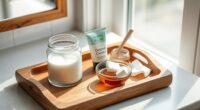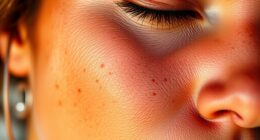In winter, your skin faces UV damage from reflected snow and cloud penetration, but you can reverse this by using broad-spectrum sunscreen daily, even on overcast days. Incorporate rich moisturizers with ingredients like hyaluronic acid and ceramides to repair dehydration and strengthen your skin barrier. Gentle exfoliation and antioxidant serums also promote renewal. Keeping up with proper skincare now supports long-term healing and resilience—keep going to discover more effective winter skin repair tips.
Key Takeaways
- Use antioxidant serums to neutralize free radicals and promote skin repair from UV damage during winter.
- Incorporate gentle exfoliants to remove dead skin cells and enhance the skin’s natural regeneration process.
- Apply rich moisturizers with ceramides, hyaluronic acid, and glycerin to restore hydration and strengthen the skin barrier.
- Protect skin daily with broad-spectrum SPF 30+ sunscreen to prevent further UV-induced damage in cloudy or snowy conditions.
- Maintain a consistent skincare routine focusing on hydration, protection, and repair to reverse winter skin damage effectively.

Winter can be harsh on your skin, stripping away moisture and leaving it dry, flaky, and dull. The cold air, low humidity, and indoor heating combine to deprive your skin of essential hydration, making it more vulnerable to damage. To combat this, you need to adjust your moisturizing routines and adopt effective sun protection strategies, even in the winter months. Moisturizing is your first line of defense. Use richer creams or ointments that create a barrier, locking in moisture better than lighter lotions. Look for ingredients like hyaluronic acid, glycerin, and ceramides, which help draw water into your skin and restore its natural barrier. Don’t forget to apply moisturizer immediately after showering or washing your face, when your skin is still damp, to maximize hydration. Reapply throughout the day if needed, especially if you’re exposed to dry indoor air or wind. Drinking plenty of water also supports your skin’s hydration from within, so stay well-hydrated to complement your topical efforts.
Additionally, understanding the importance of celebrity transformations can inspire you to adopt new skincare routines that help your skin recover and rejuvenate after winter damage.
Sun protection strategies remain essential during winter, even when the sun feels less intense. UV rays can penetrate clouds and reflect off snow, increasing your risk of sun damage. Applying a broad-spectrum sunscreen with at least SPF 30 every day is vital, especially on exposed areas like your face, neck, and hands. Don’t rely on winter clouds or overcast days to negate the need for sun protection; UV rays can still harm your skin and accelerate UV damage. Incorporate sun protection into your daily routine, just like your moisturizing routines. Wear protective clothing, wide-brimmed hats, and sunglasses when you’re outdoors for extended periods. If you’re skiing or snowboarding, make sure to reapply your sunscreen frequently, as snow can reflect UV rays and intensify exposure. Remember, UV damage accumulates over time, leading to premature aging, dark spots, and even skin cancer. Protecting your skin now can prevent long-term harm and help your skin recover from winter UV exposure.
In addition to moisturizing routines and sun protection strategies, consider using gentle exfoliants to remove dead skin cells, promoting renewal and a brighter complexion. Incorporate antioxidant serums to fight free radicals that cause premature aging and skin damage. By combining these steps, you support your skin’s natural repair process and restore its health after winter’s harsh effects. Consistency is key—make these practices part of your daily routine, and you’ll notice your skin becoming healthier, more resilient, and better prepared to face the winter months.
Frequently Asked Questions
Can UV Damage Worsen During Winter Despite Less Sun Exposure?
Yes, UV damage can worsen during winter even with less sun exposure. Indoor UV exposure from windows still penetrates your skin, contributing to skin aging and damage. You might not notice it as quickly, but it accumulates over time. Protect your skin by applying broad-spectrum sunscreen daily, wearing protective clothing, and limiting time near windows. Staying vigilant helps prevent further UV damage and keeps your skin healthier year-round.
Are There Specific Ingredients Best for Repairing Winter-Damaged Skin?
Think of your skin as a fortress under siege; winter’s cold and UV rays weaken its walls. To repair this damage, you need antioxidant serums packed with vitamin C or E to fight free radicals. Pair them with hydrating moisturizers containing hyaluronic acid or glycerin to restore moisture. These ingredients help rebuild your skin’s barrier, making it resilient against future winter assaults and reversing existing damage.
How Often Should I Apply Sunscreen in Winter?
You should reapply sunscreen every two hours during outdoor winter activities for ideal winter sun protection. If you’re sweating or wiping your face, reapply sooner. Don’t forget to apply sunscreen on cloudy days, as UV rays penetrate clouds. Consistent sunscreen reapplication is key to preventing further UV damage, especially in winter when you might overlook sun protection. Make it part of your daily routine for effective winter skin repair.
Does Cold Weather Cause More Skin Dehydration Than Sun Exposure?
Cold weather can cause more skin dehydration than sun exposure because the low temperatures and wind increase moisture loss from your skin. This weakens your skin barrier, making it prone to dryness and irritation. While sun exposure also dehydrates, the harsh cold strips moisture more aggressively, so you need to focus on hydrating and protecting your skin barrier with rich moisturizers during winter. Keep skin hydrated to maintain your overall skin health.
Can Indoor Heating Increase UV Skin Damage Risk?
Indoor heating doesn’t directly increase UV skin damage risk, but it can dry out your skin, making it more vulnerable. Plus, UV reflection from snow or shiny surfaces can intensify exposure even indoors if you’re near windows. To protect your skin, use moisturizer regularly, wear SPF when near reflective surfaces, and limit prolonged exposure to heated indoor environments. This helps prevent further UV damage during colder months.
Conclusion
Now that you know how cold months can damage your skin, it’s time to take action. Embrace nourishing moisturizers, protect with SPF, and stay hydrated to repair UV damage effectively. Some believe that layering oils can boost repair, and while evidence varies, many find it helpful. Trust your skin’s signals, stay consistent with your routine, and enjoy healthier, more resilient skin all winter long. Your efforts will pay off, revealing a radiant glow despite the chill.









